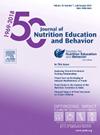美国农村地区糖尿病患者与非糖尿病患者膳食摄入量的比较。
IF 2.3
3区 医学
Q2 EDUCATION, SCIENTIFIC DISCIPLINES
引用次数: 0
摘要
目的:比较某县农村糖尿病患者和非糖尿病患者的替代健康饮食指数(aHEI)得分,并分析两组之间的食物/饮料亚组差异。方法:采用横断面调查方法,对纽约州苏利文县农村居民的食物频率问卷进行验证。我们比较了糖尿病患者和非糖尿病患者的aHEI总分和成分得分。结果:155名糖尿病患者年龄较大,非西班牙裔白人较少,平均体重指数高于961名非糖尿病患者。我们发现糖尿病患者的aHEI得分(54.1)低于非糖尿病患者(56.7)(P = 0.001)。糖尿病患者在酒精饮料、红肉、坚果/豆类和反式脂肪方面的成分得分明显低于没有糖尿病的人。结论和意义:我们的研究结果强调了在高危农村社区开展营养教育的必要性。我们还确定了农村糖尿病患者应针对改善血糖控制的特定食品/饮料类别。本文章由计算机程序翻译,如有差异,请以英文原文为准。
A Comparison of Dietary Intake Among Rural Americans With and Without Diabetes
Objective
To compare alternative Healthy Eating Index (aHEI) scores among residents with or without diabetes in a rural county and analyze food/drink subgroups for notable differences between the 2 groups.
Methods
We performed cross-sectional surveys and validated food frequency questionnaires among rural residents in Sullivan County, New York. We compared total aHEI and component scores between participants with and without diabetes.
Results
The 155 respondents with diabetes were older, less frequently non-Hispanic White, and had higher mean body mass index than the 961 respondents without diabetes. We found lower aHEI scores among participants with diabetes (54.1) than those without (56.7) (P = 0.001). Respondents with diabetes had significantly lower component scores for alcoholic beverages, red meat, nuts/legumes, and trans-fats than those without diabetes.
Conclusions and Implications
Our findings highlight the need for nutrition education in high-risk rural communities. We also identified specific food/drink categories among rural residents with diabetes that should be targeted to improve glycemic control.
求助全文
通过发布文献求助,成功后即可免费获取论文全文。
去求助
来源期刊
CiteScore
4.20
自引率
11.50%
发文量
379
审稿时长
44 days
期刊介绍:
The Journal of Nutrition Education and Behavior (JNEB), the official journal of the Society for Nutrition Education and Behavior, is a refereed, scientific periodical that serves as a global resource for all professionals with an interest in nutrition education; nutrition and physical activity behavior theories and intervention outcomes; complementary and alternative medicine related to nutrition behaviors; food environment; food, nutrition, and physical activity communication strategies including technology; nutrition-related economics; food safety education; and scholarship of learning related to these areas.
The purpose of JNEB is to document and disseminate original research and emerging issues and practices relevant to these areas worldwide. The Journal of Nutrition Education and Behavior welcomes evidence-based manuscripts that provide new insights and useful findings related to nutrition education research, practice and policy. The content areas of JNEB reflect the diverse interests in nutrition and physical activity related to public health, nutritional sciences, education, behavioral economics, family and consumer sciences, and eHealth, including the interests of community-based nutrition-practitioners. As the Society''s official journal, JNEB also includes policy statements, issue perspectives, position papers, and member communications.

 求助内容:
求助内容: 应助结果提醒方式:
应助结果提醒方式:


